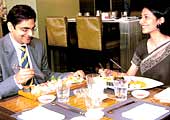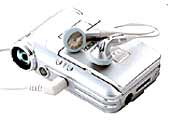|
|
|
The right pick: Sakura,
Delhi
|
|
|
Delhi/Sakura:
Part of Metropolitan Hotel Nikko, founded to cater, largely, to
Japanese visitors, this is as authentic as the sushi experience
gets. The service is top-notch as is the food. Meal for two: Rs
3,500-4,000. Contact: 011- 52500200
Delhi/Others: TK's at Hyatt Regency
has an interactive Teppanyaki grill; Enoki at The Grand serves
Yakitori cuisine, and stand-alone Tamura does a bit of everything
within a budget. Contact: 011-55771312 for the first, 011-26771234
for the second and 011-26154082 for the last.
Mumbai/Wasabi: Wasabi by Morimoto,
part of the Taj at Apollo Bunder, is the best sushi restaurant
in India. It recently made it to the Conde Nast Traveller's list
of the top 25 restaurants in the world (for this year). Meal for
two: Rs 3,000-4,000. Contact: 022-56653366
 Bangalore/Zen:
The Leela Palace Kempinski's Zen has some 15-20 types of sushi
on offer, including veggie options like the herbal sushi, made
with herbs plucked from the hotel's own kitchen garden. Executive
Chef Rudolf Eichele knows his sushi, sashimi, and miso and will,
if you choose to ask him (and he has the time), tell you how to
progress through a sushi meal (start with the mildly-flavoured
fish like salmon and end with strongly- flavoured seafood like
tuna or crab). Meal for two: Rs 1,500-2,500. Contact: O80-25211234 Bangalore/Zen:
The Leela Palace Kempinski's Zen has some 15-20 types of sushi
on offer, including veggie options like the herbal sushi, made
with herbs plucked from the hotel's own kitchen garden. Executive
Chef Rudolf Eichele knows his sushi, sashimi, and miso and will,
if you choose to ask him (and he has the time), tell you how to
progress through a sushi meal (start with the mildly-flavoured
fish like salmon and end with strongly- flavoured seafood like
tuna or crab). Meal for two: Rs 1,500-2,500. Contact: O80-25211234
Hyderabad/Cinnabar Redd: Not exactly
a sushi place, but on the menu are vegetarian sushi, smoked salmon
sushi, shrimp sushi and California sushi. Meal for two: Rs 600-700.
Contact: 040-55777733
The
Day I Made Sushi...
... and learnt from master Sadik Khan.
 |
| Spoilt for choice: Wasabi takes the
sushi |
My
podgy hands, alas, are not made to handle the $350 (Rs 15,400)
sushi knife, as they have just tried to. What they can do is to
dextrously move a piece of raw fish, wrapped in some rice soaked
in vinegar, and, in turn, wrapped in a strand of seaweed, the
one-and-a-half feet that separates the plate from my mouth. I
am doing this, like many of India's rich and famous have done,
at Mumbai's latest hot spot and, arguably, the best Japanese restaurant
in the country, Wasabi by Morimoto at the Taj Mahal Hotel.
 Sushi,
I discover isn't all raw fish. "Sushi is actually a preparation
made from short-grain (not sticky) rice, which has been kept in
vinegar and which is then topped, stuffed or rolled with a variety
of ingredients, including sea food that could be raw, cooked or
cured," says Sadik Khan, Sous Chef, Wasabi. If this restaurant,
which can hold its own against the best sushi places in the world,
is unique, it is because almost half its menu is vegetarian. "The
world is shifting towards vegetarianism," explains Hemant
Oberoi, the man behind Wasabi and Executive Grand Chef, Taj Mahal
Hotel, Mumbai. "There is a large clientele in this city that
happens to be vegetarian, and we have adapted our menu to the
dietary restrictions of our customers." Sushi,
I discover isn't all raw fish. "Sushi is actually a preparation
made from short-grain (not sticky) rice, which has been kept in
vinegar and which is then topped, stuffed or rolled with a variety
of ingredients, including sea food that could be raw, cooked or
cured," says Sadik Khan, Sous Chef, Wasabi. If this restaurant,
which can hold its own against the best sushi places in the world,
is unique, it is because almost half its menu is vegetarian. "The
world is shifting towards vegetarianism," explains Hemant
Oberoi, the man behind Wasabi and Executive Grand Chef, Taj Mahal
Hotel, Mumbai. "There is a large clientele in this city that
happens to be vegetarian, and we have adapted our menu to the
dietary restrictions of our customers."
However, the most fascinating thing about
eating sushi, whether it be topped (nigiri), rolled (maki) or
sashimi, which is nothing more than a plain slice of fish, is
the surgeon-like precision with which the chefs cut, chop and
roll their creations. The knife, sharpened every evening on seven
different sharpening stones, is a sight to behold in itself. In
Japan, I learn from Khan, who has been watching my own attempts
with the knife with some amusement, a sushi chef spends three
years cleaning and gutting fish before he is allowed to cut. And
here I am, trying to do it in a day. Still, that didn't spoil
my meal.
P.S: Wasabi is a pungent sauce made from
horse-radish, which is grated and served alongside sushi and sashimi.
-Kushan Mitra
TREADMILL
Don't Drink And Lift
 The
most ripped guy in my gym also works out the hardest. He's around
28-29, amazingly fit and sets for himself a punishing workout
schedule that he keeps re-jigging; he stretches and warms up before
exercising and cools down after every workout. He also supplements
his diet with whey protein (probably creatine too). All this shows.
He has the perfect body, embellished with some daredevil tattoos.
In short, our ripped guy is a readymade icon for gym advertisements,
straight out of the copybook. The
most ripped guy in my gym also works out the hardest. He's around
28-29, amazingly fit and sets for himself a punishing workout
schedule that he keeps re-jigging; he stretches and warms up before
exercising and cools down after every workout. He also supplements
his diet with whey protein (probably creatine too). All this shows.
He has the perfect body, embellished with some daredevil tattoos.
In short, our ripped guy is a readymade icon for gym advertisements,
straight out of the copybook.
So imagine my surprise when recently he told
me that he drinks every weekend and on days that he doesn't work
out. "A couple of shots of rum, maybe three, or two or three
beers," he grinned. But doesn't that interfere with the basic
idea behind weight-training: building stronger muscles? That's
when he smiled and added that he always made sure he ate some
high-protein food-like chicken or other meat-while he imbibed
his weekly quota of alcohol. "Alcohol," he explained
with a conspiratorial wink, "gets absorbed faster in the
blood than other foods, so eating protein with alcohol ensures
speedy delivery of protein to the system."
I was aghast by his explanation. That's when
it occurred to me that most people, including the well-buffed
ones sweating it out at gyms, have scant knowledge about the havoc
alcohol can create if you're strength training.
Regular readers will remember Treadmill's
rant against alcohol in the past. Here's a second instalment.
Alcohol has nothing but empty calories. No nutrients, only empty
calories: a 330-ml bottle of beer can add 145 calories and a 60-ml
shot of whiskey as much as 125 calories. And if shedding fat and
weight is all about burning off more calories than you add, then
alcohol merely adds more for you to burn off. So, if you're serious
about losing weight and/or building muscle mass through exercise,
alcohol can only make the job harder. Just consider: if you weigh
80 kg, you would need to run at 12 kmph for nearly 20 minutes
or more to burn the calories that just two beers can add. And
believe me, that's strenuous running.
But alcohol is not just about empty calories.
Alcohol consumption can lower protein synthesis by as much as
20 per cent. One reason: alcohol dehydrates muscle cells and,
as many know, without hydration, anabolic activity (the building
of muscle) is hindered. The dehydration occurs because the body's
water is diverted to the kidneys where alcohol is metabolised
instead of being used to process other nutrients, including protein.
If that is not bad enough, alcohol also constrains the absorption
of other nutrients like phosphorus, iron, magnesium and calcium-all
of which are needed for muscle growth and strength.
So, never mind what you've heard. Booze and
big muscles don't go together.
-Muscles
Mani
write to musclesmani@intoday.com
Caveat: The physical exercises described
in Treadmill are not recommendations. Readers should exercise
caution and consult a physician before attempting to follow any
of these.
OF
DELICATE HEARTS
The way to a
woman's heart is, ahem, often clogged, much more often, and at
a younger age, than it was perhaps a decade ago. Blame it on liberalisation,
or women's emancipation, but the Indian woman's tryst with heart
diseases is well and truly here to stay. Here's the lowdown:
Causes: Lifestyle changes are the main culprit.
As more and more women opt for jobs, the effects of late hours
and, yes, partying are beginning to tell. Add to that an increase
in smoking and drinking, plus the stress of looking after the
household, and you have a lethal cocktail. Says
Dr. R.R. Kasliwal, Director (Cardiology),
Escorts Heart Institute and Research Centre, Delhi: "Women
are subject to more stress than men because they have to look
after both fronts, job and home." Net result: an increase
in heart diseases.
Who's at risk: Post-menopausal women
have been traditionally more vulnerable due to a reduction in
the female hormone, estrogen, which protects the heart. But now,
that's changing. Says Dr Vijay Mohan Kohli, Senior Consultant
(Cardiac Surgery), Sir Ganga Ram Hospital, Delhi: "Pre-menopausal
women are also susceptible now. The more ambitious a woman is,
the greater the risk."
Symptoms: Classic symptoms include
chest pain, breathlessness and fatigue. But with women, there's
an added dimension. Says Kohli: "Women may not show typical
symptoms of heart ailments, just a dull ache in the back or the
neck."
What you can do: If you're over 35,
get a medical check-up done that includes checking your waist
circumference (85 cm is ideal, says Kasliwal), blood pressure,
blood sugar and lipid profile. Also, eat healthy, burn excess
calories through exercise, and cut down on those cigarettes and
alcohol. And please, don't wait for symptoms to show up. As Kasliwal
says, "For 30 per cent people, sudden death is the first
symptom." You don't want to wait for that.
-Alokesh Bhattacharyya
PRINTED
CIRCUIT
Small Is Fun
The PlayStation PSP
 If
you like trashing (and thrashing) aliens on your computer or game
console at home, you must bemoan the fact that you can't do the
same when you're getting bored during your daily commute. Or when
you get bored during the chairman's speech. Or whenever. Games
on regular mobile phones don't cut it, unless you have a Nokia
N-Gage, that is. Now, Sony and Nintendo have raised the stakes
with their new portable gaming machines, the PlayStation PSP and
the Nintendo DS. The PSP (recently launched through the legal
route in India) is a tremendous little thing and has been described
as the future of gaming (Sony doesn't think so; it wants PlayStation3
to be the future of gaming), a 333-mhz processor and 32-mb ram
in a 20-cm package, featuring a brilliant 10.5-cm 16-million colour
LCD screen and, most importantly, games that really keep you occupied
through even the most interesting meetings (Rengoku and Ridge
Racer come to mind). Sure, it has its problems-additional memory,
through Sony's proprietary Memory Stick format costs a lot of
money-but this is, as we've said before, the future of gaming.
Price: Rs 19,990 (legal import, via Milestone) If
you like trashing (and thrashing) aliens on your computer or game
console at home, you must bemoan the fact that you can't do the
same when you're getting bored during your daily commute. Or when
you get bored during the chairman's speech. Or whenever. Games
on regular mobile phones don't cut it, unless you have a Nokia
N-Gage, that is. Now, Sony and Nintendo have raised the stakes
with their new portable gaming machines, the PlayStation PSP and
the Nintendo DS. The PSP (recently launched through the legal
route in India) is a tremendous little thing and has been described
as the future of gaming (Sony doesn't think so; it wants PlayStation3
to be the future of gaming), a 333-mhz processor and 32-mb ram
in a 20-cm package, featuring a brilliant 10.5-cm 16-million colour
LCD screen and, most importantly, games that really keep you occupied
through even the most interesting meetings (Rengoku and Ridge
Racer come to mind). Sure, it has its problems-additional memory,
through Sony's proprietary Memory Stick format costs a lot of
money-but this is, as we've said before, the future of gaming.
Price: Rs 19,990 (legal import, via Milestone)
 1
Picture=Thousand Bytes 1
Picture=Thousand Bytes
Photosharing
Sure, digital
photography has engendered a new class of trigger-happy photo-fiends,
but it still remains difficult to share pictures. The joy of having
one's visual memories in digital format can only be matched by
the frustration of having to individually attach pictures to e-mails
when they need to be shared. The solution? Online photo-sharing.
There are lots of sites that offer you the ability to upload your
digital images and host them for no charge-but the best services
are provided by www.kodakgallery.com (which asks you if you want
prints of the images, a service not yet available in India) and
Yahoo's www.flickr.com, which allows you to not only share pictures
but easily post them on to weblogs. Flickr's popularity, in particular,
seems to have convinced Microsoft (the company is never the first
to do something, is it?) to launch its Max photosharing service,
www.microsoft.com/max. All sites have restricted upload limits
for free users, but they are the easiest way of getting your picture
across!
Everyman's Everything
Samsung VP/N 2100 Miniket
 If
you've watched television in the past few months, chances are
you've seen the rather entertaining ad for Samsung's Miniket (it's
the one where a young man goes to an office party, captures some
rather interesting footage of the company's senior managers on
his Miniket, and soon finds himself heading the firm's Mediterranean
operations). Well, the product is to be launched in India this
month; we say product because it is a camcorder, a digital camera,
a portable storage device (it has a 1-gb hard drive), a webcam,
a voice recorder, and an mp3 player. The sound quality is good,
though not quite iPod; the picture quality, given the thingamajig's
2-megapixel lens, is again good, not great; and the video-recorder
can hold its own against any of the species. Now, if only it were
a gsm phone too. Price: Rs 59,000 If
you've watched television in the past few months, chances are
you've seen the rather entertaining ad for Samsung's Miniket (it's
the one where a young man goes to an office party, captures some
rather interesting footage of the company's senior managers on
his Miniket, and soon finds himself heading the firm's Mediterranean
operations). Well, the product is to be launched in India this
month; we say product because it is a camcorder, a digital camera,
a portable storage device (it has a 1-gb hard drive), a webcam,
a voice recorder, and an mp3 player. The sound quality is good,
though not quite iPod; the picture quality, given the thingamajig's
2-megapixel lens, is again good, not great; and the video-recorder
can hold its own against any of the species. Now, if only it were
a gsm phone too. Price: Rs 59,000
-Compiled by Kushan Mitra
|





 Bangalore/Zen:
The Leela Palace Kempinski's Zen has some 15-20 types of sushi
on offer, including veggie options like the herbal sushi, made
with herbs plucked from the hotel's own kitchen garden. Executive
Chef Rudolf Eichele knows his sushi, sashimi, and miso and will,
if you choose to ask him (and he has the time), tell you how to
progress through a sushi meal (start with the mildly-flavoured
fish like salmon and end with strongly- flavoured seafood like
tuna or crab). Meal for two: Rs 1,500-2,500. Contact: O80-25211234
Bangalore/Zen:
The Leela Palace Kempinski's Zen has some 15-20 types of sushi
on offer, including veggie options like the herbal sushi, made
with herbs plucked from the hotel's own kitchen garden. Executive
Chef Rudolf Eichele knows his sushi, sashimi, and miso and will,
if you choose to ask him (and he has the time), tell you how to
progress through a sushi meal (start with the mildly-flavoured
fish like salmon and end with strongly- flavoured seafood like
tuna or crab). Meal for two: Rs 1,500-2,500. Contact: O80-25211234
 Sushi,
I discover isn't all raw fish. "Sushi is actually a preparation
made from short-grain (not sticky) rice, which has been kept in
vinegar and which is then topped, stuffed or rolled with a variety
of ingredients, including sea food that could be raw, cooked or
cured," says Sadik Khan, Sous Chef, Wasabi. If this restaurant,
which can hold its own against the best sushi places in the world,
is unique, it is because almost half its menu is vegetarian. "The
world is shifting towards vegetarianism," explains Hemant
Oberoi, the man behind Wasabi and Executive Grand Chef, Taj Mahal
Hotel, Mumbai. "There is a large clientele in this city that
happens to be vegetarian, and we have adapted our menu to the
dietary restrictions of our customers."
Sushi,
I discover isn't all raw fish. "Sushi is actually a preparation
made from short-grain (not sticky) rice, which has been kept in
vinegar and which is then topped, stuffed or rolled with a variety
of ingredients, including sea food that could be raw, cooked or
cured," says Sadik Khan, Sous Chef, Wasabi. If this restaurant,
which can hold its own against the best sushi places in the world,
is unique, it is because almost half its menu is vegetarian. "The
world is shifting towards vegetarianism," explains Hemant
Oberoi, the man behind Wasabi and Executive Grand Chef, Taj Mahal
Hotel, Mumbai. "There is a large clientele in this city that
happens to be vegetarian, and we have adapted our menu to the
dietary restrictions of our customers."  T
T If
you like trashing (and thrashing) aliens on your computer or game
console at home, you must bemoan the fact that you can't do the
same when you're getting bored during your daily commute. Or when
you get bored during the chairman's speech. Or whenever. Games
on regular mobile phones don't cut it, unless you have a Nokia
N-Gage, that is. Now, Sony and Nintendo have raised the stakes
with their new portable gaming machines, the PlayStation PSP and
the Nintendo DS. The PSP (recently launched through the legal
route in India) is a tremendous little thing and has been described
as the future of gaming (Sony doesn't think so; it wants PlayStation3
to be the future of gaming), a 333-mhz processor and 32-mb ram
in a 20-cm package, featuring a brilliant 10.5-cm 16-million colour
LCD screen and, most importantly, games that really keep you occupied
through even the most interesting meetings (Rengoku and Ridge
Racer come to mind). Sure, it has its problems-additional memory,
through Sony's proprietary Memory Stick format costs a lot of
money-but this is, as we've said before, the future of gaming.
Price: Rs 19,990 (legal import, via Milestone)
If
you like trashing (and thrashing) aliens on your computer or game
console at home, you must bemoan the fact that you can't do the
same when you're getting bored during your daily commute. Or when
you get bored during the chairman's speech. Or whenever. Games
on regular mobile phones don't cut it, unless you have a Nokia
N-Gage, that is. Now, Sony and Nintendo have raised the stakes
with their new portable gaming machines, the PlayStation PSP and
the Nintendo DS. The PSP (recently launched through the legal
route in India) is a tremendous little thing and has been described
as the future of gaming (Sony doesn't think so; it wants PlayStation3
to be the future of gaming), a 333-mhz processor and 32-mb ram
in a 20-cm package, featuring a brilliant 10.5-cm 16-million colour
LCD screen and, most importantly, games that really keep you occupied
through even the most interesting meetings (Rengoku and Ridge
Racer come to mind). Sure, it has its problems-additional memory,
through Sony's proprietary Memory Stick format costs a lot of
money-but this is, as we've said before, the future of gaming.
Price: Rs 19,990 (legal import, via Milestone)
 If
you've watched television in the past few months, chances are
you've seen the rather entertaining ad for Samsung's Miniket (it's
the one where a young man goes to an office party, captures some
rather interesting footage of the company's senior managers on
his Miniket, and soon finds himself heading the firm's Mediterranean
operations). Well, the product is to be launched in India this
month; we say product because it is a camcorder, a digital camera,
a portable storage device (it has a 1-gb hard drive), a webcam,
a voice recorder, and an mp3 player. The sound quality is good,
though not quite iPod; the picture quality, given the thingamajig's
2-megapixel lens, is again good, not great; and the video-recorder
can hold its own against any of the species. Now, if only it were
a gsm phone too. Price: Rs 59,000
If
you've watched television in the past few months, chances are
you've seen the rather entertaining ad for Samsung's Miniket (it's
the one where a young man goes to an office party, captures some
rather interesting footage of the company's senior managers on
his Miniket, and soon finds himself heading the firm's Mediterranean
operations). Well, the product is to be launched in India this
month; we say product because it is a camcorder, a digital camera,
a portable storage device (it has a 1-gb hard drive), a webcam,
a voice recorder, and an mp3 player. The sound quality is good,
though not quite iPod; the picture quality, given the thingamajig's
2-megapixel lens, is again good, not great; and the video-recorder
can hold its own against any of the species. Now, if only it were
a gsm phone too. Price: Rs 59,000